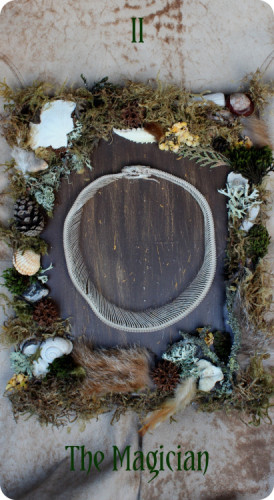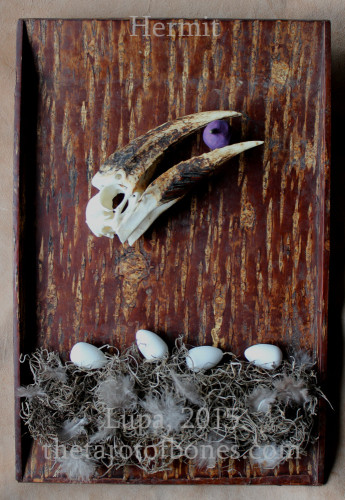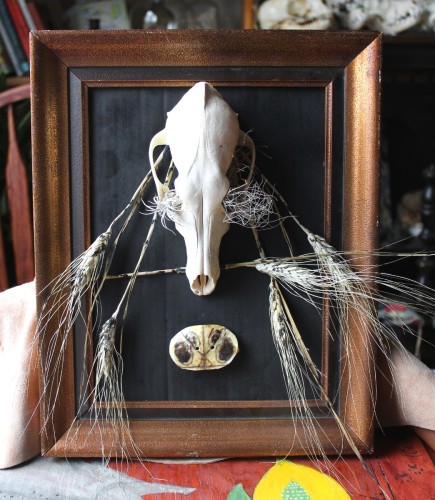Crowdfunding to finance a project is nothing new in Pagan circles, sometimes successful, sometimes less successful. And new tarot decks aren’t exactly thin on the ground either. So a crowdfunding effort by a Pagan to finance a new tarot deck would have to be something very unique and appealing to have even a slim chance of succeeding.
Lupa Greenwolf’s Tarot of Bones crowdfunding Indiegogo campaign hit its goal in less than 100 hours.
The deck isn’t yet created, but the campaign page shows a few photos, and one mock up of what it will look like. From these visuals, it easy to see why it appealed to so many people. It is unlike any tarot deck you’ve seen before. For each of the 78 cards, Lupa arranges animal bones and other other natural materials onto a display board. She then takes a photo of the display and, from that, will create the cards. A companion book for the deck will explore the symbolism of each card in detail, including her inspiration.
Sage Runepaw is one of the people who helped fund the Tarot of Bones campaign. He said that he wanted the deck because it is so unique. “I decided to contribute to her campaign because the tarot decks out there have nothing like what she is offering,” said Runepaw, adding “It will be a unique addition to the greater collective of decks and I believe it will stand out.”

© Lupa Greenwolf
Lupa is an artist and author from the Portland, Oregon area. She said that she started reading tarot cards in 1996, shortly after becoming a Pagan. By 1998 she was incorporating animal hides, bones and other natural items in her artwork and spirituality. Several of the books that she has written are focused on nature spirituality, and now she’s bringing together all those portions of her life to create the Tarot of Bones.
The Wild Hunt caught up with Lupa and asked her about this project, what the Tarot of Bones means to her, and why she thinks it’s such a success.
Cara Schulz: Why do you think this deck, one created out of photos of animals bones and other parts, had such an appeal that it was funded in under 100 hours?
Lupa Greenwolf: One factor is the trend in taxidermy and other curiosities as aesthetically pleasing motifs. I’ve been making my hide and bone art since 1998, and I’ve watched as in the past few years natural history specimens have become chic decor. Taxidermy’s always been a beautiful art, even when it was primarily relegated to those of us who grew up in rural areas, but it’s reached a broader audience since then. Some of that appeal is purely looks-based–Portland is full of hipster establishments that have a couple of “ironic” taxidermy animal heads on the wall, for example.
However, there are also people who are genuinely interested in natural history, and who appreciate taxidermy and related arts both for their beauty and their preservation of specimens. Of course, there have always been Pagans running around picking up bones and moss and stuff in the woods. But I’ve observed the sort of nature-inspired art in which I engage gaining in broader popularity in recent years. I know I’ve gone from being that weird girl with a collection of dead things to becoming the founder and organizer of Curious Gallery, a two-day yearly arts festival here in Portland that celebrates modern-day cabinets of curiosity, due in part to this growth of interest.
More specifically regarding tarot, the majority of decks out there are fairly anthropocentric–that is, they concentrate mostly on human-centered symbolism. There have always been decks that focus on non-human animals, or on plants, or other natural phenomena, though many of them are more generalized oracle decks that depart heavily from the traditional tarot’s 78 cards. Many of the animal-based tarot decks still have a lot of human animals running around in them with their critter companions. So I think there’s definitely a demand for divination sets that still stick to the tarot framework but which depart from the usual “humans doing things” imagery.
I have worked hard for many years to get my creations out to where others can enjoy them, and I do have to give a lot of credit to fans of my work when it comes to the success of this campaign. I am absolutely and eternally grateful to the growing number of people who have been enjoying my artwork and my books and other writing. Some of them are dear friends, many are people I’ve never met in person (though some of them seem quite sweet over email), but all of them have just given me such a morale boost over the years, never mind the financial support of my work. So while I don’t think people would buy something just because I created it, there are some backers who thought me being the artist and author was a good incentive to chip in.
CS: Can you explain one of the cards and why you choose to create it the way you did?
LG: Oh, I get to talk about one of my favorite cards I’ve made! So when I was first plotting out which animals best fit my interpretation of each card, there were some that were really persnickety and wouldn’t come to a conclusion easily. But then there were a few where the combination just worked, immediately and perfectly. The Hermit was one of those. I chose a female black-casqued hornbill skull that I got from the Bone Room for very good reason.

© Lupa Greenwolf
So. Hornbills are a group of birds endemic to Africa and Asia. Some species nest on the ground, but others nest up in trees. These tree-nesting hornbills seek out a crevice high in a tree trunk, big enough for the female to climb in. She and the male then wall up the opening with a delightful mix of mud, fruit pulp and bird poop, until there’s only a small bit left open. Did I mention the female is inside the tree when this happens? She stays in there for the duration of laying, incubating and hatching her eggs. She’s so dedicated that she moults all of her flight feathers; even if she broke out she couldn’t go much of anywhere. So she’s pretty committed at this point.
This was the very first thing I thought of when I started meditating on the Hermit. Here we have this figure who, like the hornbill, goes into a productive solitude. He’s not just antisocial; he’s gaining wisdom that eventually he’ll bring back to the community. In the same way, the female hornbill comes out of her isolation both with a shiny new set of flight feathers and the newest generation of baby hornbills to join the forest community. I think that’s quite appropriate for the Hermit card, and I also enjoyed being able to break that card out of its usual gender stereotype.
CS: When you set $5000 as your goal, did you think you would hit it?
LG: I was pretty dubious. $5,000 is a lot of money to ask people to give for something that isn’t even going to take material form for another year and a quarter. Actually, $5,000 is just a lot of money period. And it’s my very first limited-time crowdfunding campaign. My first foray into crowdfunding was my Patreon account, which I started last summer.
While I have awesome people who like my work, I’m not one of those really well-known artists or authors whose work routinely goes super-viral. I’ve been posting my art, blog posts and the like in various places online, and I’ll usually get some likes and comments on Facebook and a few dozen notes on Tumblr and a handful of likes and retweets on Twitter. Occasionally there’s an outlier; people REALLY liked the Magician assemblage for the Tarot of Bones, for example. But I’m not getting hundreds of shares for every piece of art or writing I post. So I was really startled (and grateful) when I got this tidal wave of response to the IndieGoGo campaign!
I admit I was coming up with contingency plans in case the campaign didn’t get funded–right up until the first day ended and it was already a third of the way there. Okay, to be honest, I was still making backup plans through Day 2, just in case Day 1 was a weird fluke. Apparently I set the bar too low, because everyone so far has showed me how much I didn’t need to worry. And now I’ve had to scramble to figure out stretch goals because the campaign is still going for another month and change and who knows at what level of funding it’ll end?
I do want to note that even though the campaign is now over $6,000, we’re far from the point where I’m just shoveling money into my pockets. The initial $5,000 was mainly meant to help me buy the rest of the materials I needed for the assemblage pieces, which I estimated at about $3500, less IndieGoGo’s and Paypal’s fees, of course. The leftovers from that would be put toward various administrative costs–printing and shipping, fulfilling perks, and so forth. The final costs are still a lot more than $6,000; this is part of why the IndieGoGo campaign isn’t my only form of funding for this project. That being said, the better it does, the easier it’ll be for me to stick to my production schedule for the Tarot of Bones and the less time I’ll have to spend in other fundraising pursuits instead of just making the set already!
CS: How did you get the idea for this deck – it’s very unusual!
LG: I show my work at local galleries, and last October I was in a group show with a tarot theme held at Splendorporium in SE Portland. I created a piece, “Blight,” inspired by the Five of Pentacles, which is a card commonly associated with financial and material strife, something that a lot of people in the current economy still have to deal with. It had a simple black background with a single coyote skull in the center, flanked by five ears of wheat that I had spattered with black paint to represent fungal blight, and a piece of red slider turtle shell to represent coinage.

© Lupa Greenwolf
The piece was displayed amid other artists’ works that interpreted the tarot theme in a variety of media and motifs, and between the fun of creating “Blight” and being immersed in this gorgeously curated collection, I started thinking that I really wanted to work with the tarot imagery even more. So there was that fateful moment after the opening, when I was hanging out with my partner and a friend of ours, where I said the thing so many other esoterically-minded artists have said: “I’m going to create a tarot deck!” And of course being the overachiever that I am, I couldn’t just do a deck–it had to have a full-length companion book, too.
I didn’t just go home and start throwing bones at things though. There are very specific reasons for the bones and other materials in the assemblages. The Major Arcana each have a complete animal skull whose species has been chosen for the appropriateness of the card; each court card has a partial skull with a missing or detached jawbone, and a single bone that represents its suit. The suits of the Minor Arcana are represented by specific types of bone: vertebrae for pentacles, teeth or jaws for swords, long bones for wands and ribs for cups. I also had to make sure that the bones I selected were both legal to possess and could be obtained sustainably. In a few cases I chose to use resin replicas of skulls. I strongly dislike resin because as a plastic it’s petroleum-based, which means it produces a lot of pollution in its manufacture and, unlike natural bone, it won’t safely biodegrade over time. But sometimes it’s the only option.
CS: Anything else that people should know about this project?
LG: I want to reiterate that the Tarot of Bones is a nature-based deck. One of my goals with it is to entice my fellow Homo sapiens back into our place in nature — not necessarily as hominin apes in the wilderness, but humans with an acute and conscious awareness of our interconnectedness with everything else. It’s part of why most of the materials are recycled or reclaimed; almost all of the backboards for the assemblages are thrift store finds like old cutting boards and TV trays, and many of the other materials, from acrylic paints to dried moss, are secondhand as well. And as with all of my work for the past almost-twenty years, I will be donating a portion of the money I make from the Tarot of Bones to nonprofit organizations that benefit wildlife and their habitats.
Folks who are reading this, even if you can’t back the campaign at this time, please pass the link on to other people who may like the project! Word of mouth goes a long way in this sort of promotion, and I would be quite grateful.
I have to admit there’s part of me that really, really hopes someone goes for one of the bigger Art Collector Packages, where one of the perks is an original assemblage used in the creation of the Tarot of Bones. Partly because I like seeing my art go to people who enjoy it, and partly because I live in a tiny apartment and the twenty-three pieces I’ve already completed are eating up the wall space and I still have fifty-five to go!
The Wild Hunt is not responsible for links to external content.
To join a conversation on this post:
Visit our The Wild Hunt subreddit! Point your favorite browser to https://www.reddit.com/r/The_Wild_Hunt_News/, then click “JOIN”. Make sure to click the bell, too, to be notified of new articles posted to our subreddit.

Thank you again for the interview! I really appreciated the chance to get in depth about the Tarot of Bones; these were some nice, meaty questions (despite being about bones).